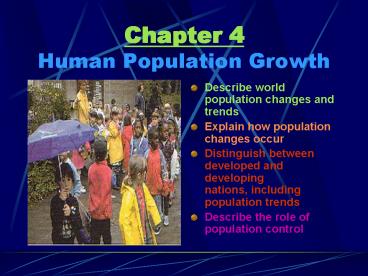Chapter 4 Human Population Growth PowerPoint PPT Presentation
1 / 20
Title: Chapter 4 Human Population Growth
1
Chapter 4Human Population Growth
- Describe world population changes and trends
- Explain how population changes occur
- Distinguish between developed and developing
nations, including population trends - Describe the role of population control
2
Terms
- Birth rate
- Death rate
- Demography
- Developed country
- Developing country
- Fertility rate
- Life expectancy
- Migration
- Natural population change
- Population
- Population control
- Replacement fertility rate
- Total fertility rate
- Zero population growth
3
Population
- Is the number of people in a location
4
Current Population
- The world has a population of 5.6 billion people
- It is increasing at the rate 3 per 254,000 per
day or 1.7 a year - Worldwide increases have been most rapid since
1950 - Better health care and improved nutrition help
people live longer - Fewer infants and small children are dying before
adulthood - Expected to decline after about the year 2050 as
developing countries improve living conditions
5
Demography
- Demography is the science of human population
- Common demographic information includes age,
gender, income, race, and education - The countries in Africa, Asia, and Latin America
have the highest population growth - Europe and North America have the lowest
population growth - The worlds population will double by 2030 or at
least by 2050
6
(No Transcript)
7
Population Change
- Natural change
- Birth and death rate
- Population declines
- Migration
- Opportunity for prosperity
- Rural to urban migration
8
Birth and Death Rates
- The birth rate (fertility rate) is the average
number of births per 1,000 people per year - The death rate (mortality rate) is the average
number of deaths per 1,000 people per year - Currently, each minute in the world, 270 babies
are born and 90 people die, population increases
180 people a minute
9
Population Declines
- Occur when the birth rate is not adequate to
maintain the population - Migration and death rate exceeds the birth rate
and immigration - Europe, Russia and Ukraine also have decline
population
- The death rate declines because of
- Development in disease control and treatment
- Food and nutrition are important
- Prevent accidents and injuries
10
Migration
- Opportunity for prosperity
- Seeking new opportunity and occupation
- Rural to urban migration
- Problems related to quality of life
11
(No Transcript)
12
(No Transcript)
13
Extent of Development
- Developed country
- Is industrialized
- Higher income
- Fewer needed in farming
- Science and technology is high
- About 45 countries as Europe, North America,
Japan, New Zealand, Australia
- Developing country
- Is not industrialized
- Low income and poor
- Based on subsistence farming
- Few job in business and industries
- About 125 countries in Africa, Latin America,
Asia, Caribbean, Oceania
14
Contrasting Birth Rate
- Developed countries
- Japan 10 babies/1,000 people a year
- USA 9/1,000
- Developing countries
- Pakistan 45/1,000
- China 21/1,000
15
Fertility Rate
- Replacement fertility rate
- Indicates the number of children needed to
replace those who die - Important measure of the ability of a population
to maintain itself - Developed countries, RFR is about 2.1 babies per
female - Developing countries is 2.5 babies per female
- Total fertility rate
- Is the average number of children a woman will
have - TFR for the world is currently 3.3 babies per
female - Developed countries 1.9
- Developing countries 3.7
16
Life Expectancy
- Is the number of years that a newborn baby may be
expect to live - All countries average 66 years
- Developed countries 75 years
- Developing countries 63 years
- Japan 79 years
- Sierra Leone 43 years
17
(No Transcript)
18
Population Control
- How many people can the resources of the world
support? - Population control is reducing the rate of
population increase - Zero population growth reflects a birth rate
equal to the death rate
19
Acceptance of Population Control
- The past
- Large families because children could help the
work - Children could care in later years
- The present
- Small families
- Prepare for their live as older adults
- Fertility rates declines as educational levels
increase
20
Tests
- How is the worlds population predicted to change
in the next 50 years? - How do natural population changes influence world
population? Contrast natural changes with changes
caused by migration. - What are the major differences in population
trends between the industrialized and developing
countries? - How can population growth be controlled?
- Do you feel that some from of limitation on
births is desirable? Why?

